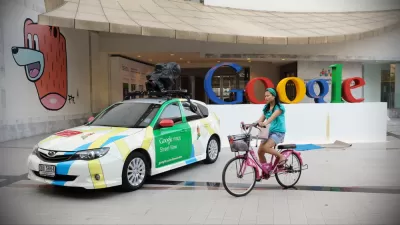Vanity Fair has published the first rendering of the design for the new "Googleplex", the first offices to be built by the tech giant from scratch.
In its offices throughout the world, Google's 35,000+ employees all work in buildings that were remodeled to suit the company's needs. Thus, observers have long wondered what the trendsetting company would build for itself, when given the chance. After two years of false starts, Paul Goldberger reports that Google has partnered with the Seattle-based firm NBBJ, to produce the vision for a new Googleplex "that looks, at first glance, like an updated version of one of the many suburban office parks that Google has made a practice of taking over and re-doing for its own needs."
With many of its tech brethren choosing to situate their offices in urban environments, the suburban nature of the visionary company's headquarters may disappoint some. But according to Goldberger, "[t]he more you look at the complex,...the more intriguing it is." The campus is composed of nine four-story bent rectangles, several with green roofs, that form multiple courtyards. "And cars, the bane of almost every suburban office complex, including the Googleplex, are hidden away."
For Goldberger, the most intriguing aspect of the project is the process and analysis that led to the design. "The layout of bent rectangles, then, emerged out of the company’s insistence on a floor plan that would maximize what [David Radcliffe, a civil engineer who oversees the company’s real estate] called 'casual collisions of the work force.' No employee in the 1.1-million-square-foot complex will be more than a two-and-a-half-minute walk from any other, according to Radcliffe."
“We started not with an architectural vision but with a vision of the work experience,” Radcliffe said. “And so we designed this from the inside out.”
For a zoomable view of the design, check out this post on Quartz.
FULL STORY: Exclusive Preview: Google’s New Built-from-Scratch Googleplex

Alabama: Trump Terminates Settlements for Black Communities Harmed By Raw Sewage
Trump deemed the landmark civil rights agreement “illegal DEI and environmental justice policy.”

Study: Maui’s Plan to Convert Vacation Rentals to Long-Term Housing Could Cause Nearly $1 Billion Economic Loss
The plan would reduce visitor accommodation by 25% resulting in 1,900 jobs lost.

Planetizen Federal Action Tracker
A weekly monitor of how Trump’s orders and actions are impacting planners and planning in America.

Wind Energy on the Rise Despite Federal Policy Reversal
The Trump administration is revoking federal support for renewable energy, but demand for new projects continues unabated.

Passengers Flock to Caltrain After Electrification
The new electric trains are running faster and more reliably, leading to strong ridership growth on the Bay Area rail system.

Texas Churches Rally Behind ‘Yes in God’s Back Yard’ Legislation
Religious leaders want the state to reduce zoning regulations to streamline leasing church-owned land to housing developers.
Urban Design for Planners 1: Software Tools
This six-course series explores essential urban design concepts using open source software and equips planners with the tools they need to participate fully in the urban design process.
Planning for Universal Design
Learn the tools for implementing Universal Design in planning regulations.
Caltrans
Smith Gee Studio
Institute for Housing and Urban Development Studies (IHS)
City of Grandview
Harvard GSD Executive Education
Toledo-Lucas County Plan Commissions
Salt Lake City
NYU Wagner Graduate School of Public Service





























